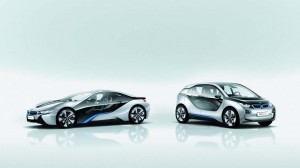BMW plans to rapidly expand its battery-car line-up, according to various sources, adding two more models to the new i sub-brand that it has already confirmed will include the little i3 and sporty 18 models.
The two new models, i4 and i5, will make extensive use of super-light carbon fiber to enhance performance and improve energy efficiency and range. That appears to suggest the German maker believes it can dramatically reduce the cost of the composite material, which is currently too expensive to use on anything other than the most expensive of sports cars – such as the new Lamborghini Aventador.
The two new models likely won’t appear on the market before late in the decade, report both Autoblog.com and Bimmerfile, with concept versions expected to be revealed sometime after the 2014 launch of the i8, the most expensive of the models currently planned for BMW’s new i brand-within-a-brand.
Based on the popular Vision EfficientDynamics concept revealed at the 2009 Frankfurt Motor Show, the i8 is, “the sports car for a new generation – pure, emotional and sustainable,” suggested BMW tech chief Klaus Draeger, during its formal unveiling, last month.
It’s expected to cost somewhere under $100,000, fully-loaded, while the i3 city car – originally dubbed the BMW MegaCity vehicle — should come in at about half that figure. The i4 coupe will share the smaller model’s basic platform and carbon fiber “Life” architecture, as well as its extended-range electric drive system — with a similar price tag. According to some sources, it will adopt a 2-seater configuration, rather than then 4-seat i3 design, with a wider stance, sloping roof and more sporty layout.
Various sources indicate the i5 will be a larger, coupe-like sedan with a similar plug-in drivetrain to the one planned for the i8 – which could yield as much as 400 lb-ft of torque, reports Autoblog, when the gas and electric drives are operating together. That would be a particularly powerful package considering the use of carbon fiber.
BMW has been investing heavily in carbon fiber development, which “has a number of appealing advantages,” Ian Robertson, the BMW AG Board Member who supervises Mini sales and marketing, told TheDetroitBureau.com earlier this year. It is not just light but extremely strong, which is why it is being used on a variety of advanced racing platforms, including Formula One. But the real challenge will be to both reduce its cost and increase the speed with which it can be produced and assembled into products like the new BMW i models.

